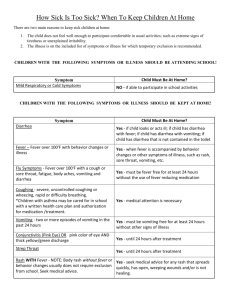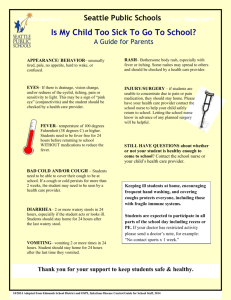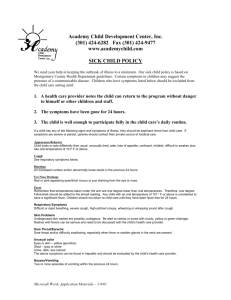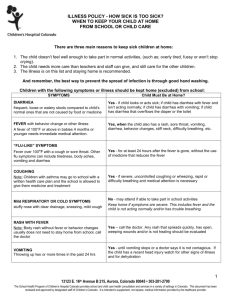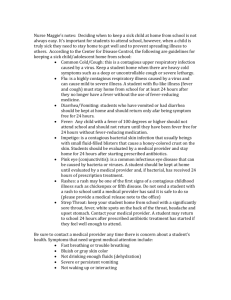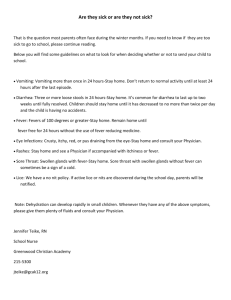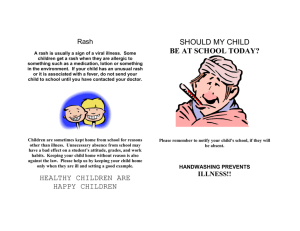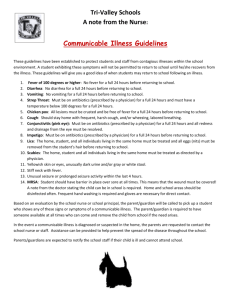When to keep Children at home when to send kids home 92210
advertisement
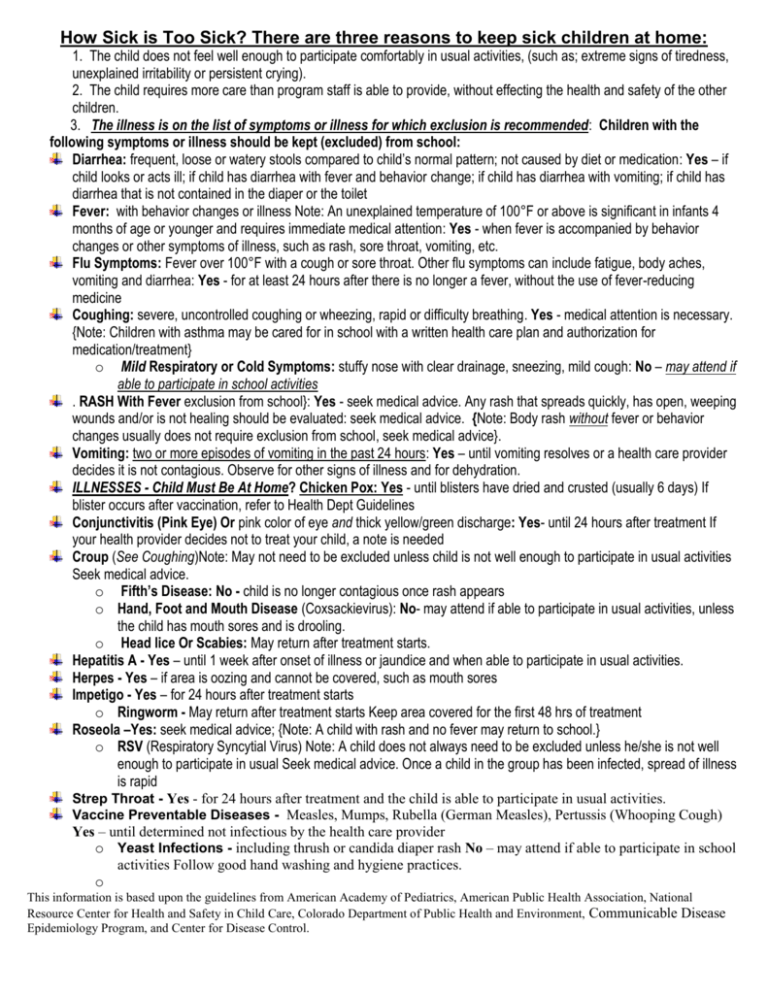
How Sick is Too Sick? There are three reasons to keep sick children at home:
1. The child does not feel well enough to participate comfortably in usual activities, (such as; extreme signs of tiredness,
unexplained irritability or persistent crying).
2. The child requires more care than program staff is able to provide, without effecting the health and safety of the other
children.
3. The illness is on the list of symptoms or illness for which exclusion is recommended: Children with the
following symptoms or illness should be kept (excluded) from school:
Diarrhea: frequent, loose or watery stools compared to child’s normal pattern; not caused by diet or medication: Yes – if
child looks or acts ill; if child has diarrhea with fever and behavior change; if child has diarrhea with vomiting; if child has
diarrhea that is not contained in the diaper or the toilet
Fever: with behavior changes or illness Note: An unexplained temperature of 100°F or above is significant in infants 4
months of age or younger and requires immediate medical attention: Yes - when fever is accompanied by behavior
changes or other symptoms of illness, such as rash, sore throat, vomiting, etc.
Flu Symptoms: Fever over 100°F with a cough or sore throat. Other flu symptoms can include fatigue, body aches,
vomiting and diarrhea: Yes - for at least 24 hours after there is no longer a fever, without the use of fever-reducing
medicine
Coughing: severe, uncontrolled coughing or wheezing, rapid or difficulty breathing. Yes - medical attention is necessary.
{Note: Children with asthma may be cared for in school with a written health care plan and authorization for
medication/treatment}
o Mild Respiratory or Cold Symptoms: stuffy nose with clear drainage, sneezing, mild cough: No – may attend if
able to participate in school activities
. RASH With Fever exclusion from school}: Yes - seek medical advice. Any rash that spreads quickly, has open, weeping
wounds and/or is not healing should be evaluated: seek medical advice. {Note: Body rash without fever or behavior
changes usually does not require exclusion from school, seek medical advice}.
Vomiting: two or more episodes of vomiting in the past 24 hours: Yes – until vomiting resolves or a health care provider
decides it is not contagious. Observe for other signs of illness and for dehydration.
ILLNESSES - Child Must Be At Home? Chicken Pox: Yes - until blisters have dried and crusted (usually 6 days) If
blister occurs after vaccination, refer to Health Dept Guidelines
Conjunctivitis (Pink Eye) Or pink color of eye and thick yellow/green discharge: Yes- until 24 hours after treatment If
your health provider decides not to treat your child, a note is needed
Croup (See Coughing)Note: May not need to be excluded unless child is not well enough to participate in usual activities
Seek medical advice.
o Fifth’s Disease: No - child is no longer contagious once rash appears
o Hand, Foot and Mouth Disease (Coxsackievirus): No- may attend if able to participate in usual activities, unless
the child has mouth sores and is drooling.
o Head lice Or Scabies: May return after treatment starts.
Hepatitis A - Yes – until 1 week after onset of illness or jaundice and when able to participate in usual activities.
Herpes - Yes – if area is oozing and cannot be covered, such as mouth sores
Impetigo - Yes – for 24 hours after treatment starts
o Ringworm - May return after treatment starts Keep area covered for the first 48 hrs of treatment
Roseola –Yes: seek medical advice; {Note: A child with rash and no fever may return to school.}
o RSV (Respiratory Syncytial Virus) Note: A child does not always need to be excluded unless he/she is not well
enough to participate in usual Seek medical advice. Once a child in the group has been infected, spread of illness
is rapid
Strep Throat - Yes - for 24 hours after treatment and the child is able to participate in usual activities.
Vaccine Preventable Diseases - Measles, Mumps, Rubella (German Measles), Pertussis (Whooping Cough)
Yes – until determined not infectious by the health care provider
o Yeast Infections - including thrush or candida diaper rash No – may attend if able to participate in school
activities Follow good hand washing and hygiene practices.
o
This information is based upon the guidelines from American Academy of Pediatrics, American Public Health Association, National
Resource Center for Health and Safety in Child Care, Colorado Department of Public Health and Environment, Communicable Disease
Epidemiology Program, and Center for Disease Control.
